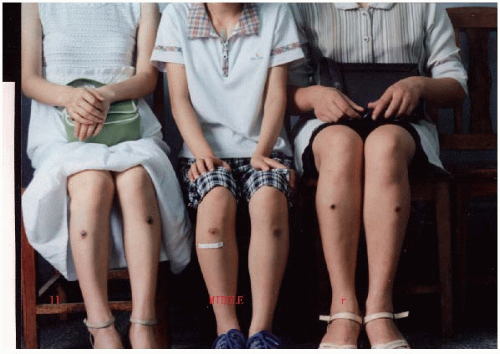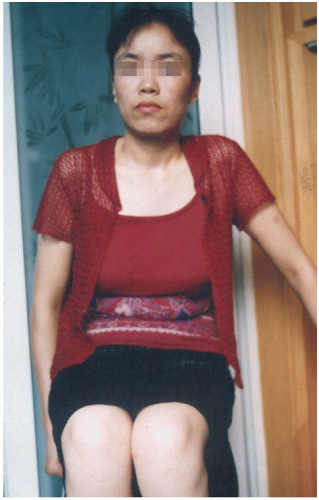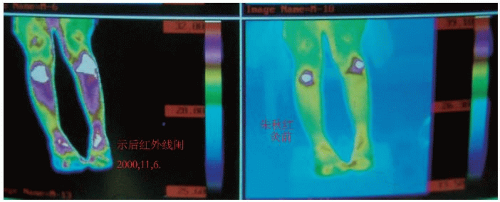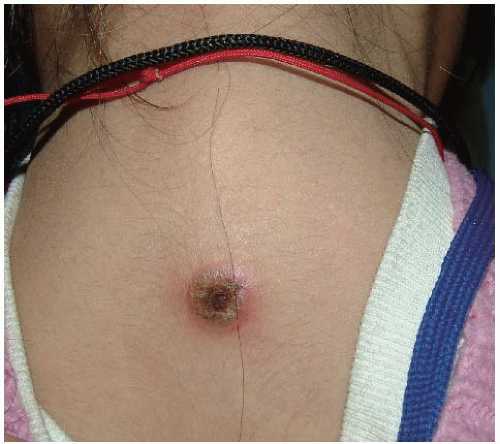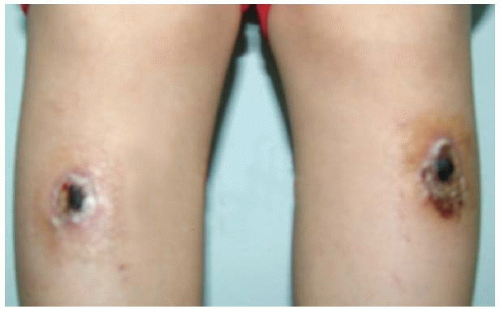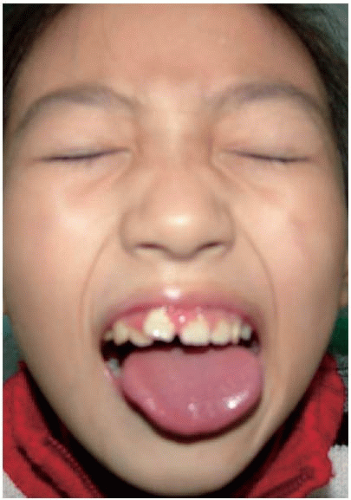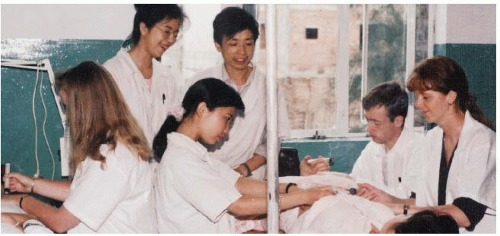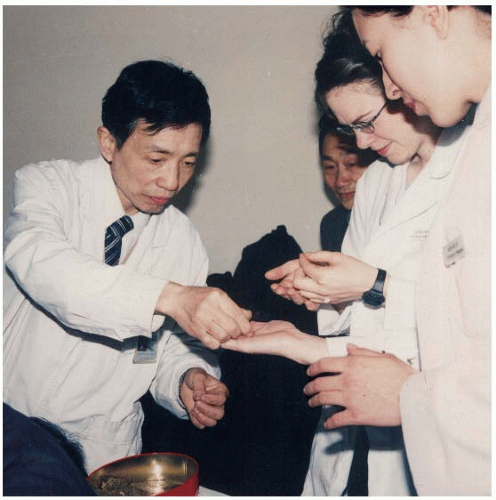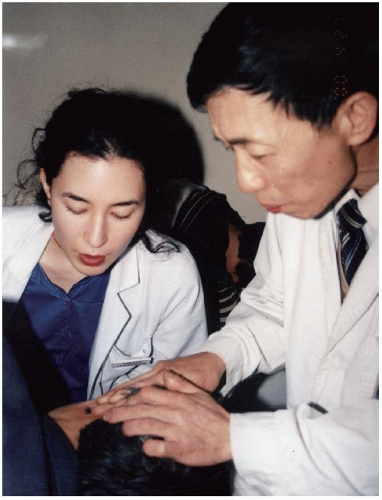Clinical Practice and Research of Moxibustion
Section 1 Brief Summary of Moxibustion Practice on Professor Li Himself
As the proverb says that “nothing ventured, nothing gained” “practice makes perfect”, Professor Li has been practicing moxibustion on himself since 1985. The first time, Professor Huang Shengyuan applied moxibustion on Li’s Taixi (KI 13) point. After one-year of observation, Professor Li was then applied moxibustion on Chengshan (BL 57). It was found that Professor Li did not feel any discomfort except for some discoloration. To prevent disease and keep health, he applied moxibustion on Zusanli (ST 36) from 1990 and from then on, he did it four or five times every month. He had herpes simplex on February 10th, 1996. After treatment with medicine, there was no response. He then chose moxibustion on Zusanli (ST 36). Two weeks later, he was the completely recovered. November 20th, 1997, herpes appeared on Li’s both upper extremities, with extreme itching, due to an infection of the fingers. After two weeks of treatment with western and Chinese medicine, there was still no relief. Then he was treated by burning moxibustion on Zusanli (ST 36) for three days, and had obvious relief. Eight days later, he had a complete recovery (Fig. 3-1a, Fig. 3-1b). He did some practice on himself at an evaluation meeting. He applied moxibustion on Shangjuxu (ST 37) by moxibustion stick sized 2cm×2.5cm (Fig. 3-2). Seven hours later, a blister appeared, and then formed a scab. After the scab was removed, a cut of 5.5cm×3.5cm was found. After the treatment of western and Chinese medicine, there was no effect. Then he attempted to apply burning moxibustion on Zusanli (ST 36) after which he had a full recovery of the cut on August 20th. Professor Li persisted doing moxibustion every month and as well as when he felt achy. He started a journal on moxibustion April 1997 and kept it for 4 years without interruption. From his own experiences he obtained a lot of first hand experience. Professor Li adopts over moxibustion to cure the diseases and good results have been obtained (Fig. 3-3). He teaches the students both at home and abroad (Fig. 3-4, Fig. 3-5).
 Fig. 3-3 Professor Li is administering the moxibustion to Professor Li Zhong-yu of Chengdu University of TCM. |
Section 2 Why Do They Accept Moxibustion
Why has traditional acupuncture and moxibustion been popular for several thousand years until now? Its colorful cultural essence should raise our reconsideration. First, why do people accept moxibustion treatment, especially those who have some difficult diseases? The reason is that moxibustion can basically get rid of the disease. Second, although the fast advancement of modern science and technology has promoted the development of diagnostic technology, treatment techniques in comparison somewhat lag behind. As a result, moxibustion rightly narrows the gap between them. Third, why has moxibustion aroused an international attention and even attracted some foreign patients to China for moxibustion treatment? This is basically due to the remarkable effect of the natural treatment method—moxibustion. Finally, why do some healthy people accept moxibustion treatment? People accepting moxibustion treatments include not only patients, but also some healthy people, such as doctors, nurses and healthcare students. The reason is that moxibustion has become a preventative method to health maintenance. Cases are presented as follows:
Case 1 (Fig. 3-6, left)
Ms. Tian, female, 24, nurse. Chief complaint: Eyesight in progressive decline for two years. She was diagnosed as optic neuritis by neurologist and was treated by hormones. There was no obvious effect after two years. Later, she was treated by burning moxibustion, and meanwhile the hormone was decreased until no longer needed. One year later, her eyesight became normal and remains normal for the following eight years.
Case 2 (Fig. 3-6, middle)
Ms An, female, 22, farmer. Chief complaint: Postpartum massive hemorrhage followed by three months of blindness. She was diagnosed with acute optic neuritis by the neurologist and ophthalmologist. After being treated in the hospital
for one month, she could count fingers. After seven months’ treatment after being discharged, her eyesight had no further recovery. Then she chose burning moxibustion and at the same time progressively reduced the dosage of hormone until no longer needed. After seven moxibustion treatments, her eyesight was restored to 0.5 and then normalized within two months. The eyesight remained normal the follow-up eight years.
for one month, she could count fingers. After seven months’ treatment after being discharged, her eyesight had no further recovery. Then she chose burning moxibustion and at the same time progressively reduced the dosage of hormone until no longer needed. After seven moxibustion treatments, her eyesight was restored to 0.5 and then normalized within two months. The eyesight remained normal the follow-up eight years.
Case 3 (Fig. 3-6, right)
Ms Gu, female, 25, farmer. Chief complaint: Eyesight in progressive decline for two years. After delivering a baby one year ago, her eyesight gradually became worse (left 0.2, right 0.4), she complained of dim eyesight, pain in the back and neck and felt tired. Diagnosed as optic neuritis by ophthalmologist, she was treated for one year without obvious effect. Neurologists gave the same diagnosis. Then she was treated by burning moxibustion on the Zusanli (ST 36) with 6-8 moxa cones once a day and every six days was a course of treatment. Three courses later, her eyesight was restored to 0.6 (left) and 0.8 (right). Two more months later, her eyesight became normal.
Case 4
Ms. Xia, female, 27, doctor. Chief complaint: Three spontaneous abortions. She was treated for tocolysis three times in the hospital, but failed. Having poor health
(Fig. 3-7), she was advised to try burning moxibustion (Fig. 3-8). Three months later, she was pregnant in February 2003 and had no other treatment. She delivered a baby on 24th November. She and her baby have been in good health for the past three years until present. (Fig. 3-9).
(Fig. 3-7), she was advised to try burning moxibustion (Fig. 3-8). Three months later, she was pregnant in February 2003 and had no other treatment. She delivered a baby on 24th November. She and her baby have been in good health for the past three years until present. (Fig. 3-9).
Case 5
Zhu, an 11-year-old girl. Chief complaint (by her parents): Because of dystocia, she received emergency treatment in the first seven days after birth and could not speak or walk at the age of 2. She suffered from hydrostomia, light lips and texture of tongue, whitish coating over the tongue (Fig. 3-10). After continuously applying burning moxibustion to Zusanli (ST 36) with 4-6 moxa cones each time for 14 days, her parents took moxa back home and applied burning moxibustion. The girl would come back for a 2-day observation every month, and half a year later she could slowly walk (Fig. 3-11). The infrared thermogram taken on November 9, 2000 pointed to a marked change after the burning moxibustion (Fig. 3-12). Two years later, the burning moxibustion was terminated due to unknown reasons. The girl continued to suffer from hydrostomia and inflexible tongue until she was ten years old. She was diagnosed as short fraenum linguae by stomatologists and was recommended to have surgery. Her parents refused the advice and chose burning moxibustion instead. Upon consultation, neurologists suggested the girl
continue burning moxibustion, who was then applied burning moxibustion on Zusanli (ST 36) once a day. (Fig. 3-13) Two months later, the point Dazhui (DU 14) was also included. (Fig. 3-14) We recorded the moxibustion scar, which had special changes in the middle stage and was called “red peak value” (Fig. 2-13a, b, c, d, e, f). The clinical symptom improved significantly following the appearance of the read peak value (Fig. 3-15, Fig. 3-16, Fig. 3-17), so she continued to accept burning moxibustion to reinforce the effect. During the follow-up half a year, the girl was doing well in school.
continue burning moxibustion, who was then applied burning moxibustion on Zusanli (ST 36) once a day. (Fig. 3-13) Two months later, the point Dazhui (DU 14) was also included. (Fig. 3-14) We recorded the moxibustion scar, which had special changes in the middle stage and was called “red peak value” (Fig. 2-13a, b, c, d, e, f). The clinical symptom improved significantly following the appearance of the read peak value (Fig. 3-15, Fig. 3-16, Fig. 3-17), so she continued to accept burning moxibustion to reinforce the effect. During the follow-up half a year, the girl was doing well in school.
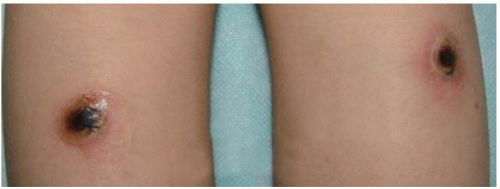 Fig. 3-13 Applying Burning Moxibustion on Zusanli (ST 36) There was much secretion on Zusanli (ST 36). |
 Fig. 3-16 The clinical symptom improved significantly following the appearance of the red peak value. |
Section 3 Why Some Americans Accept Moxibustion
Nixon’s visit to China in 1972 established a new chapter in the history of Sino-US diplomatic relations. According to a recent Chinese Acupuncture & Moxibustion Report, China developed a series of diplomatic activities 35 years ago, among which is inviting the famous columnist James Reston to visit China. James Reston is an American journalist who had great interest in Chinese traditional culture. One of the purposes for his visit to China is to gain some knowledge about acupuncture and moxibustion, as well as acupuncture anesthesia. Unfortunately, during his visit, Mr. Reston was suflereel from acute appendicitis and underwent treatment in Beijing Xiehe Hospital from July 17-28, 1971. On the 9th day after his operation, he wrote a report named Let Me Tell You About My Appendicitis Operation in Beijing to publicize the whole process of treatment, during which a one-time session of acupuncture and moxibustion freed him from the abdominal distention caused by the operation. This article was put on the first page of the New York Times. Following his recovery, Mr. Reston watched an acupuncture anesthesia operation. When talking about his impressions of that visiting tour, Mr. Reston said that he had never seen an open-skull operation using acupuncture anesthesia. It was the highlight of his trip that China has a sea of things for Americans to learn from. Statistics from Dr. Li Yongming, Chairman of American Society of TCM, showed that since James’s visit to China, American press’ interest in Chinese acupuncture and moxibustion has doubled. In the single year of 1971, about 300 articles concerning acupuncture and moxibustion were published. Precluding the first-round of the upsurge of acupuncture and moxibustion following Nixon’s visit to China in 1972, it can be said that the internationalization of acupuncture and moxibustion owes a lot to acupuncture anesthesia. And also American journalist James Reston played an important role in introducing TCM (acupuncture and
moxibustion) to the American people.
moxibustion) to the American people.
Following the normalization of Sino-US relationship, a lot of American doctors, medical students, and acupuncture and moxibustion fans came to China to learn this art of treatment. From 1987 to 2000, Professor Li Guanrong has trained more than 200 people (Fig. 3-18, Fig. 3-19, Fig. 3-20). In August 2001, he was invited to give a lecture about The Clinical Application and Study of Moxa at the 21st Century International TCM Forum held in New York and was highly praised for his lecture. In October 2003, Professor Li was invited to the 9th South America Acupuncture and Moxibustion Conference & Seminar on Related Advanced Training, where he gave a speech titled “Curing Difficult Disease by Moxibustion”. In September 2004, when Professor Li’s book Chinese-English Clinical Moxibustion was published, Gabriel Weiss, a doctor with National College of Naturopathic Medicine who is deeply interested in burning moxibustion, came to China to visit Professor Li on August 19th to learn about moxibustion. Gabriel Weiss had experienced moxibustion treatments before, and this time he watched the process of over moxibustion (Fig. 3-21, Fig. 3-22) and then asked Professor Li to practice burning moxibustion on him (Fig. 3-23). Professor Li, deeply touched by Weiss’ courage and earnestness to learn this art of treatment, happily took a photo with him (Fig. 3-24) and wrote a poem in praise of Gabriel Weiss. The poem is as follows (Fig. 3-25):
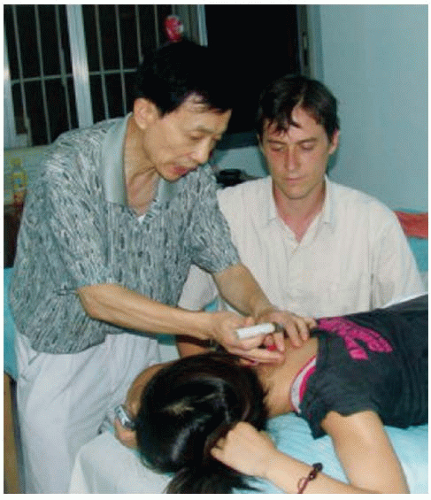 Fig. 3-21 Professor Li was showing the over moxibustion.
Stay updated, free articles. Join our Telegram channel
Full access? Get Clinical Tree
 Get Clinical Tree app for offline access
Get Clinical Tree app for offline access

|





